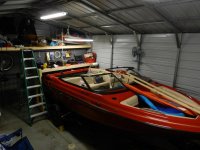Hi all, new here and kindly need some advise.
This boat is a 1994 that I've owned for about 5 years, mostly without problems until earlier this season it began starting hard and some hesitation during running. It got worse to the point it won't start at all. Initially I determined it wasn't getting spark & focused there. Now it still won't start & backfires both through the intake and exhaust. I've replaced lots of things trying to get it right, so far to no avail. Summary so far:
1. Thunderbolt IV Ignition:
Thanks, Jim
This boat is a 1994 that I've owned for about 5 years, mostly without problems until earlier this season it began starting hard and some hesitation during running. It got worse to the point it won't start at all. Initially I determined it wasn't getting spark & focused there. Now it still won't start & backfires both through the intake and exhaust. I've replaced lots of things trying to get it right, so far to no avail. Summary so far:
1. Thunderbolt IV Ignition:
Replaced spark plugs, wires, distributor cap, rotor, ignition sensor, ignition module, coil, both battery cables, new 550 cca marine battery. I bought a timing light and during cranking best I could tell it appears to be correct at 8 deg. BTDC. After replacing battery cables, cranking speed is good & voltage at coil primary went up from 9.5V to 10.8V during cranking.
2. Fuel System:
I could see fuel squirting in when opening the throttle (Weber 4 bbl carb.), so initially did not focus there. I changed & double checked the fuel water separator - no visible water. I used the electric fuel pump to totally empty the tank (concerned about bad / stale fuel) & put in fresh. Fuel pump works OK - pumps about 2.5 liters/min. I have not yet opened up the carb to clean out the inlet filters, but fuel seems to flow fine.
3. Compression:
It is supposed to be tested with a warm engine, but testing cold I read consistently about 90-95 psig across all cylinders. I know this is low, but being a cold engine - does this explain these readings? I squirted oil into a couple of cylinders, but the readings didn't change much. I haven't done a leak down test yet. I would think that bent or burnt valves would show either zero compression or at least a big variation.
So that's where I am - dreading the worst that I have to tear into the engine, at least the top end. I certainly don't want to do that until I am convinced this is the real issue. Does it make sense to rebuild the carburetor in case fuel is too lean or too rich thus causing the backfiring? Maybe play around with the timing? Any thoughts or ideas are appreciated!
Thanks, Jim


